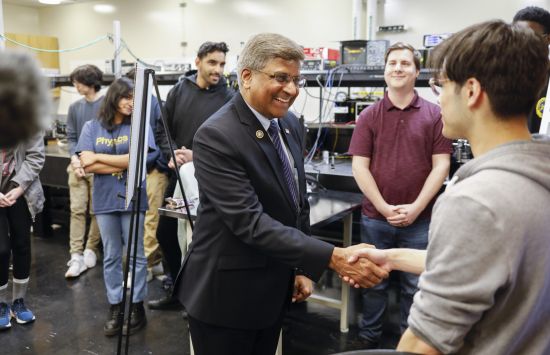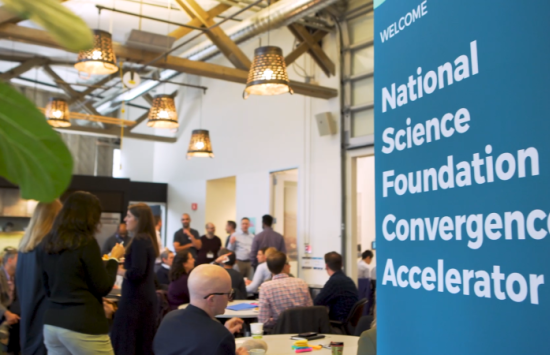This page highlights ways to work directly with NSF to invest in programs that support research and education.
Visit the Research Partnerships page to learn about NSF programs that encourage researchers to partner with industry, nonprofits and other organizations.
Who we partner with
Learn more about the different organizations with which NSF partners, and why the foundation pursues these partnerships, below.
NSF partners with federal agencies and state, tribal and local governments.
NSF's governmental partnerships focus on:
- Advancing partners' shared goals by leveraging existing expertise and reducing redundancy across the U.S. research and education portfolio.
- Bringing the partners' communities together and streamlining the proposal review process.
- Sharing information and resources to boost research productivity and enhance its benefits to society.
- Investing in components of complex projects that fulfill each partners' mission and contribute to their shared scientific goals.
NSF partners with industry to advance research and education with the potential to benefit society.
NSF's industry partnerships focus on:
- Providing the research community with use-inspired research problems, accelerating the translation of basic research to the market, and supporting the development of the workforce at all levels.
- Enabling industry to tap into the full breadth of the nation's academic research community that NSF reaches, and to benefit from NSF's merit review process to select the best proposals.
- Providing industry opportunities to work with students, the talent base for future researchers, practitioners, technicians, educators and entrepreneurs.
- Helping industry to leverage intellectual property resulting from jointly funded activities, via the same licensing terms that the federal government has.
- Pooling public and private resources to share the risks of early-stage research and amplify its benefits.
NSF's partnerships with private foundations and nongovernmental organizations focus on:
- Catalyzing new research areas and bringing broad communities of researchers, educators and practitioners together.
- Supporting innovative pilots and proofs of concept that can later be taken to scale.
- Building upon the trust that has already been established with the partner's communities.
NSF partners with international organizations to support complementary priorities between research communities in the U.S. and other countries.
NSF's international partnerships focus on:
- Providing the U.S. research community with access to expert international collaborators who have complementary expertise or who are working on topics of mutual interest.
- Giving U.S. researchers and educators access to unique facilities, infrastructure, field sites, logistical support and data sets.
- Building shared best practices, contributing to creating global expectations and norms for addressing conflicts of interest and other ethical issues in science and engineering.

Partnerships Landscape Study
This study outlines the foundation's existing partnership landscape, provides noteworthy examples and observations, and identifies the key steps NSF is taking to grow its future capacity for partnerships.
Examples of NSF's partnerships
Many of NSF's partnerships are formalized through memoranda of understanding or other signed agreements, while others are informal. The foundation's informal partnerships may include joint sponsorship of workshops or the exchange of in-kind resources in joint support of facilities, logistics or infrastructure.
Explore examples of NSF's partnerships below.
NSF deepened ties with the U.S. Air Force, a longtime provider of critical logistical support for polar research, through a letter of intent. Together, NSF and the Air Force are working to advance national security research in areas of common interest, such as space operations and geosciences, advanced materials sciences, information and data sciences, and workforce development.
NSF and USDA's National Institute of Food and Agriculture are advancing initiatives aimed at critical resources such as digital agriculture, food security, energy and water quality through a memorandum of understanding. The partnership encourages information sharing about project activities and joint support in areas of mutual interest.
Through the Graduate Research Internship Program, NSF partners with nine federal agencies providing additional research options for NSF Graduate Research Fellows at federal facilities and national laboratories in areas of national priority. Opportunities have included positions in astrophysics at the Smithsonian Institution, natural resource management at the U.S. Department of Agriculture and mineral studies at the U.S. Geological Survey.
NSF and multiple federal agencies support the National Center for Atmospheric Research, a research and development center that advances world-class research in the atmospheric and related earth system sciences.
The center has expanded understanding of many atmospheric occurrences, including geohazards such as hurricanes, geomagnetic storms and wildfires. Federal partners include the U.S. Army, Air Force, Army Corps of Engineers, the Defense Advanced Research Projects Agency and the National Oceanic and Atmospheric Administration.
NSF partnered with Intel Corp. to jointly fund advanced education and training for semiconductor manufacturing and design and to improve equitable STEM education at two-year colleges and four-year universities, including minority-serving institutions.
NSF also recently partnered with Micron Technology, Inc., to jointly fund the development of rigorous and engaging instructional material, teacher professional development and experiential opportunities for students to improve education at the nation's institutions of higher education, spanning two-year colleges and four-year universities and including minority-serving institutions, to ultimately advance semiconductor design and manufacturing.
Boeing Co. made a gift to NSF focused on strengthening the technical abilities of the nation's STEM workforce through online training in critical skill areas such as robotics, data science and artificial intelligence.
NSF recently launched a $6 million prize challenge to develop innovative learning technologies for K-12 students, made possible through a partnership with the Bill & Melinda Gates Foundation, Schmidt Futures, and the Walton Family Foundation.
The three-phase, one-year challenge, known as the Visionary Interdisciplinary Teams Advancing Learning, or VITAL, Prize Challenge, will encourage interdisciplinary teams from the science and engineering research and startup or small-business communities to advance innovative concepts into prototypes for potentially game-changing learning technologies.

Technology, Innovation and Partnerships
NSF's newest directorate ignites collaborations among academia, industry, government, nonprofits, civil society and communities of practice.
Interested in partnering with NSF?
Read NSF Partnerships: Guiding Principles
This fact sheet outlines factors NSF considers when deciding whether to embark on a new partnership.
Contact an NSF unit or program officer
Contact the NSF directorate, division or program that best aligns with your interests.


